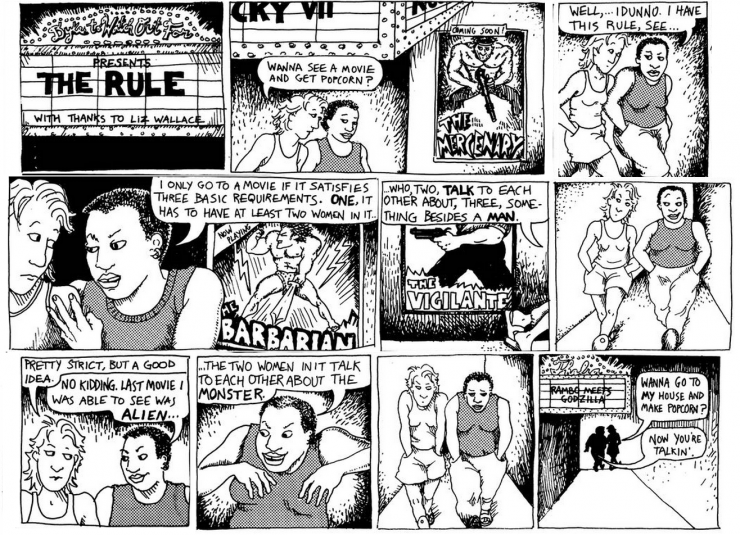On a lazy Sunday afternoon, lounging around at home with nothing to do, you decide to give your good friend Liz a call.
“Let’s go watch a movie!” you suggest.
“Which one?” Liz’s voice sounds sluggish, as if she’s also feeling restless.
“Anything will do, just to pass the time,” you reply.
“That won’t do. I have three specific criteria for watching a movie,” Liz suddenly becomes serious.
You thought she would mention genres or actors, but instead, she presents three peculiar requirements:
(1) There have to be at least 2 named female characters
(2) They have to talk to each other
(3) The conversation needs to be about something other than a man
As Liz’s criteria sank in, , your mind raced through the recent lineup of films, The Flash, Transformers, Spider-Man, Fast & Furious, these blockbusters and superhero epics seemed to fall short. What about The Little Mermaid? While it featured the vibrant mermaid Ariel and the nefarious sea enchantress Ursula, both strong female characters who surely shared interactions, Ariel’s transformative journey was driven by her longing for Prince Eric. As for the war film The Covenant, you decided to momentarily set aside the possibility of female protagonists amidst the ranks of American soldiers. The Hong Kong crime thriller Mad Fate centred around three male leads and the enigmatic murder of a sexworker, making it less suitable. And what about the British indie After Sun? It revolved around the trivialities of a father and daughter’s journey in Turkey. It suddenly struck you that finding films that perfectly aligned with Liz’s requirements was proving to be a formidable challenge indeed.
Indeed, these three film criteria originate from the esteemed “Bechdel Test,” a vital yardstick for assessing the level of gender equality in movies, literature, and other works. It was named after American cartoonist Alison Bechdel, who introduced the concept in her comic strip Dykes to Watch Out For in 1985, the test is designed to highlight gender bias and the underrepresentation of women in film.

Undoubtedly, evaluating the representation of women in films cannot be solely based on a single test, it is important to acknowledge that the Bechdel Test itself does not hold scientific rigour, prompting us to question the need for more robust standards of measurement. However, it remains a stark reality that numerous films, both past and present, fail to meet the requirements of this test (as previously mentioned in passing). Women often find themselves confined to the peripheral roles and archetypes of someone else’s daughter, lover, or mother, lacking individual agency and substantial character development. This one-dimensional portrayal, commonly referred to as “flattening”, is a recurring issue. It is worth noting that passing the test does not automatically guarantee substantial and meaningful depth in the representation of female characters.
In a deeply disheartening reality, the British film scholar Stephen Follows revealed in a 2014 statistical report that, astonishingly, films failing the Bechdel Test tend to receive higher ratings than those that pass*. Further amplifying this disconcerting trend, the polling and analysis institution FiveThirtyEight analysed 1,615 films released between 1990 and 2013, investigating the relationship between the presence of women in films, their budgets, and box office profits. Their findings revealed that films passing the test had significantly lower median budgets compared to the overall median budgets of the sampled films.
These findings underscore a stark truth: in our society, where gender encompasses a spectrum beyond binary definitions, and where women constitute nearly half of the global population, the world of cinema has regrettably lagged behind in meaningful progress. Instead of moving forward, it often exhibits a puzzling regression, perpetuating a lack of inclusivity and depth in portraying female characters.

In recent times, several tests have been developed as alternatives to the Bechdel-Wallace test, focusing on the depiction of men in modern films, such as the “reverse test”, including the rules as :
- One named male character
- Who is moral, competent and masculine
- No gratuitous belittling or domination of male characters
The creator of this test believes that following the #MeToo movement, there has been an influx of unnecessary scenes in films that predominantly feature women. However, they argue that this does not necessarily result in better representation of women. There are also other tests that address issues such as sexual orientation, race, and ethnicity, which the Bechdel test may not encompass. FiveThirtyEight has even introduced “The New Bechdel Test”, with the following questions:
- Was the supporting cast at least 50% women?
- Did a woman write or direct the film?
- Did a female lead end up dead?
- Is there a black woman in the film?
These tests serve as a powerful reminder of the significance of giving female characters a voice in film. They underscore the principles of gender equality and the celebration of diversity. By embracing a wide range of perspectives and narratives, stories can authentically reflect the intricacies of the world.
“Movies that are female-driven do not travel,” said Krista Smith, West Coast editor of Vanity Fair, describing the broader sentiment in Hollywood. The film industry is driven by profitability. If writers know from the start that male-led stories hold more market value, why would they invest in female-led narratives? The root of the problem lies in how we can elevate the market value of female-driven stories. How can we ensure that women’s films have market appeal? How can we make sure that exceptional women’s films become commercially successful?

The scene cuts back to your conversation with Liz. You racked your brain for a while, but couldn’t come up with a film that would satisfy her criteria. The more you pondered, the more exasperated you became. It was supposed to be a leisurely Sunday, yet now you found yourself grappling with a more vexing predicament than your work!
“Unless you actually watch a film, how can you determine if it meets the requirements?”
You ended the call and decided to open the television, seeking refuge in browsing YouTube videos instead.
P.S. If you’re interested, visit the user-generated website bechdeltest.com to test whether your favorite films have passed the test.
*Statistical analysis based on ratings and reviews from IMDb, Rotten Tomatoes, and Metacritic.
Photo source:The Washington Post, Santa Barbara

